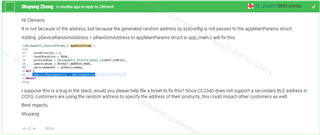Other Parts Discussed in Thread: SYSCONFIG,
I use 
and set
Then use IOS and Android phones to test respectively.
Android phone: There is a broadcast, and the address on the broadcast display has been changed to CF, FF, FF, FF, FF, CF, but connect cannot connect to it.
IOS phone: Cannot scan the broadcast
Is there any other way to successfully change the MAC Address and scan and broadcast successfully?



